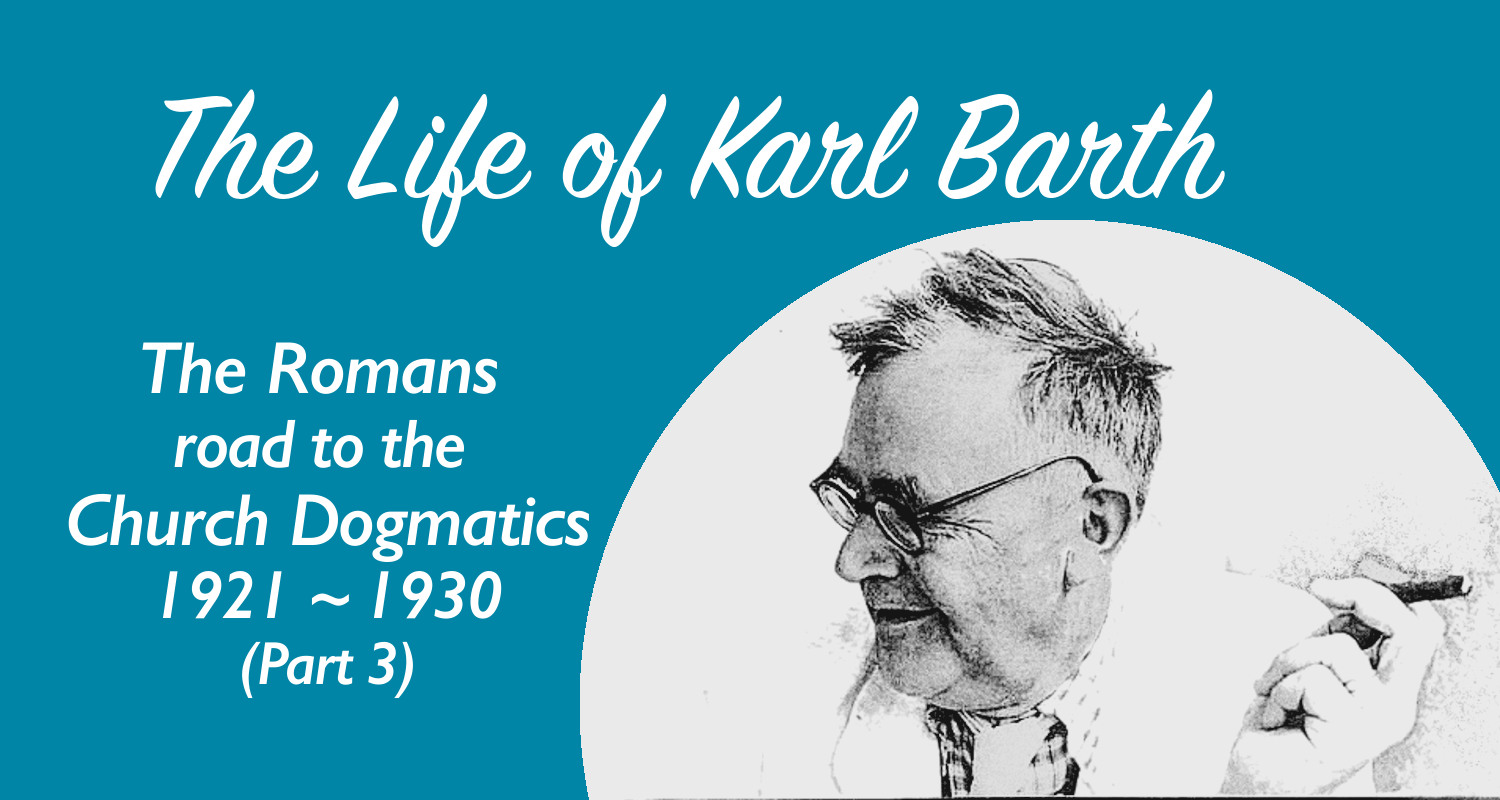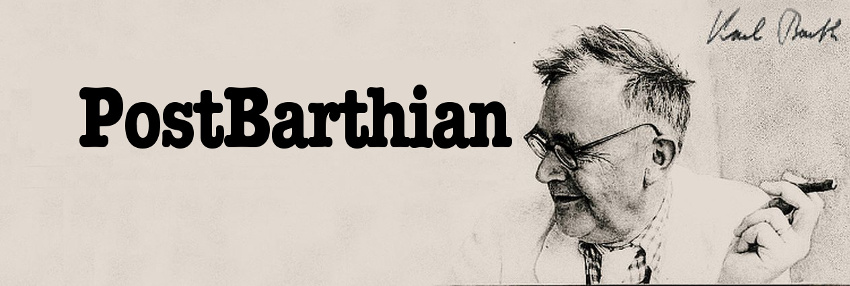
Karl Barth left his pastoral work at Safenwil in 1921 to become Honorary Professor of Reformed theology at the University of Göttingen, due to the successful first edition of his commentary on The Epistle to the Romans (Der Romerbrief, 1919). At this same time, Barth had completed the second edition of his The Epistle to the Romans, but it was not published until after he arrived in Göttingen. In part two of the Life of Karl Barth, I explained it was Barth's Romans I that led to Barth's professorship, but it was his Romans II that led to his worldwide fame—and the success of "Romans II" totally eclipsed "Romans I". In this part three of the life of Karl Barth series, I will describe the times between the times of his landmark commentary on The Epistle to the Romans and the first volume of the Church Dogmatics (CD I/1).
In case you missed it, remember to read Part 1: Karl Barth's Early Life and Part 2: The Red Pastor of Safenwil in this life of Karl Barth series.
Honorary Professor of Reformed Theology in Göttingen
When Karl Barth arrived at Göttingen, he "was to teach 'Introduction to the Reformed confession, Reformed doctrine and Reformed church life'" [1] in a city that was a Lutheran stronghold. Barth said "I can now admit that at that time I didn't even have a copy of the Reformed confessions, and I certainly hadn't read them." [2]. Students at Göttingen were not required to attend Barth's classed because he did not possess an advanced theological degree. According to Busch, at this same time, Barth was surprised to learn that he had been awarded an honorary doctorate from Munster due to the success of Romans II—Barth's daughter asked if this meant he was able to heal people—but unfortunately this doctorate wasn't rewarded due to red tape many years later.
In Göttingen from 1921 to 1925, Karl Barth cut his teeth on the Reformed confessions and forged his identity as a great Reformed theologian in the same tradition of John Calvin, Heinrich Bullinger, and John Knox and many other Reformed theologians who labored in Switzerland and became world renown. Barth was forced to learn Reformed theology as he lectured upon it—perhaps like many professors today—and was initially displeased with the initial questions and answers of the Heidelberg Catechism (the most famous Reformed Confession) but later realized that he had deep agreement with Reformed theology. Barth said, "Fortunately, it turned out that my theology had become more Reformed, more Calvinistic than I had known, so I could pursue my special confessional task with delight and with a good conscience." [3].
Many of Karl Barth's lectures have been published, including his 1921-22 lectures as The Epistle to the Ephesians, and his 1922 lectures as The Theology of John Calvin, and his 1923-24 lectures as The Theology of Schleiermacher. Barth also lectured on Huldrych Zwingli in 1922-23, but it is not published in english.
Göttingen Dogmatics
In 1924-25, Karl Barth lectured on Reformed theology, and the lectures are important because they contain the basic program of Karl Barth's theology that prefigure his later 13 volume magnum opus, the Church Dogmatics. These 1924-25 lectures were posthumously published as The Gottigen Dogmatics (only volume one of the Göttingen Dogmatics is available in english, and hopefully the remaining volume will be translated soon). In the Göttingen Dogmatics, Karl Barth's later theological program is recognizable in initial form, and in it Barth's identity as a Reformed theologian is visible, and his reliance upon the Reformed tradition is recognizable throughout it.
Friends in Göttingen
In Göttingen, Karl Barth forged his famous friendship with Rudolf Bultmann. Bultmann became Barth's arch-nemesis later in life, and many of their correspondence letters from this time have been published in Karl Barth Rudolf Bultmann Letters 1922 / 1966. (I've discussed how Barth and Bultmann's relationship was like a whale and an elephant.) Also, during this time, Barth's friendship with Emil Brunner continued to deteriorate. Lastly, Karl Barth met Charlotte von Kirschbaum who became his most significant conversation partner for the rest of Barth's life, and their relationship has remained a point of controversy and speculation to this day.
Professor in Münster and the Christian Dogmatics
In 1925, Barth left the Lutherans in Göttingen to work among the Catholics in Münster as the "Professor of Dogmatics and New Testament Exegesis" [4]. In Münster, Barth worked closely with experts in Catholic theology such as Erich Przywara, and so his writings in this time period are more polemically engaged with Catholic theology than his earlier and later periods. At the university, Barth continued to lecture and publish his 1926-27 lectures on The Letter to the Philippians). Barth's 1928-29 lectures on ethics from this time are also available in publication as Ethics. Barth's most significant (and frequently discussed) publication was his Münster dogmatics in 1927, titled the Christian Dogmatics (Kirchliche Dogmatik). The Christian Dogmatics was Barth's first (and failed) attempt to complete the work he started in his Göttingen Dogmatics lecture, and would later finally achieve in his magnum opus, the Church Dogmatics. The Christian Dogmatics is often compared to the Church Dogmatics in a similar way as Barth's Romans I is compared to Romans II.
(An important point of clarification is that the Göttingen Dogmatics was never a published work by Barth, and so "Göttingen Dogmatics" refers to the posthumous publication of Barth's 1926-27 Göttigen lectures (discussed above). The Christian Dogmatics (or Munster Dogmatics) has never been translated into English, and is an unfinished work. Since the Göttingen Dogmatics Vol.1 is available in english translation, this has caused many people to misidentify it with Barth's incomplete Christian Dogmatics.)
Professor in Bonn and the Church Dogmatics
In 1930, Karl Barth left Münster to work as a Professor in Bonn. In the next part in this series on the life of Karl Barth, I will discuss Barth's precarious times in Bonn, as World War II commence, and when Barth's began to write his most important theological works, such as the Barmen Declaration and the first volume of the Church Dogmatics (CD I/1).
The Life of Karl Barth series:
- The Life of Karl Barth: Early Life from Basel to Geneva 1886-1913 (Part 1)
- The Life of Karl Barth: The Red Pastor of Safenwil 1909-1921 (Part 2)
- The Life of Karl Barth: The Romans road to the Church Dogmatics 1921-1930 (Part 3)
- The Life of Karl Barth: Protesting in Nazi Germany 1930-1935 (Part 4)
- The Life of Karl Barth: Professor of Systematic Theology at the University of Basel during World War II 1935-1946 (Part 5)
- The Life of Karl Barth: Church Dogmatics Vol III: The Doctrine of Creation 1945-1951 (Part 6)
- The Life of Karl Barth: Church Dogmatics Vol IV: The Doctrine of Reconciliation 1953-1967 (Part 7)
- The Life of Karl Barth: Trip to America in 1962 (Part 8)
- Coming soon . . .
Sources:
1. Busch, Eberhard. Karl Barth: His Life from Letters and Autobiographical Texts. W.B. Eerdmans Pub. Co., 1994. Print. 129.
2. Ibid.
3. Ibid.
4. Barth Center: http://barth.ptsem.edu/karl-barth/biography



May 9th, 2018 - 05:54
Muchas gracias por ilustrarnos con la vida de este gran teólogo!!!